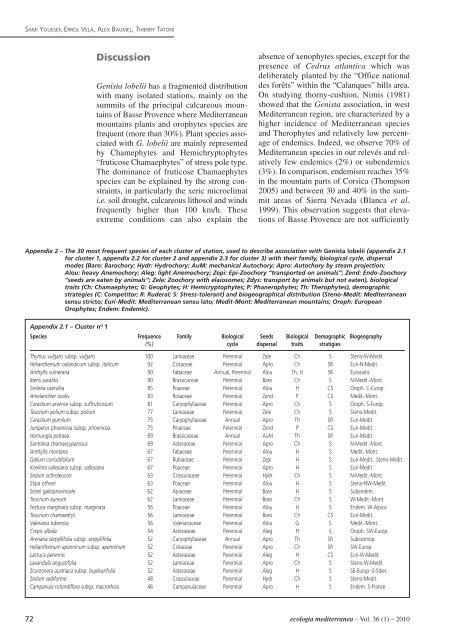Revue internationale d'écologie méditerranéenne International ...
Revue internationale d'écologie méditerranéenne International ...
Revue internationale d'écologie méditerranéenne International ...
You also want an ePaper? Increase the reach of your titles
YUMPU automatically turns print PDFs into web optimized ePapers that Google loves.
SAMI YOUSSEF, ERROL VELA, ALEX BAUMEL, THIERRY TATONI<br />
72<br />
Discussion<br />
Genista lobelii has a fragmented distribution<br />
with many isolated stations, mainly on the<br />
summits of the principal calcareous mountains<br />
of Basse Provence where Mediterranean<br />
mountains plants and orophytes species are<br />
frequent (more than 30%). Plant species associated<br />
with G. lobelii are mainly represented<br />
by Chamephytes and Hemichryptophytes<br />
“fruticose Chamaephytes” of stress pole type.<br />
The dominance of fruticose Chamaephytes<br />
species can be explained by the strong constraints,<br />
in particularly the xeric microclimat<br />
i.e. soil drought, calcareous lithosol and winds<br />
frequently higher than 100 km/h. These<br />
extreme conditions can also explain the<br />
absence of xenophytes species, except for the<br />
presence of Cedrus atlantica which was<br />
deliberately planted by the “Office national<br />
des forêts” within the “Calanques” hills area.<br />
On studying thorny-cushion, Nimis (1981)<br />
showed that the Genista association, in west<br />
Mediterranean region, are characterized by a<br />
higher incidence of Mediterranean species<br />
and Therophytes and relatively low percentage<br />
of endemics. Indeed, we observe 70% of<br />
Mediterranean species in our relevés and relatively<br />
few endemics (2%) or subendemics<br />
(3%). In comparison, endemism reaches 35%<br />
in the mountain parts of Corsica (Thompson<br />
2005) and between 30 and 40% in the summit<br />
areas of Sierra Nevada (Blanca et al.<br />
1999). This observation suggests that elevations<br />
of Basse Provence are not sufficiently<br />
Appendix 2 – The 30 most frequent species of each cluster of station, used to describe association with Genista lobelii (appendix 2.1<br />
for cluster 1, appendix 2.2 for cluster 2 and appendix 2.3 for cluster 3) with their family, biological cycle, dispersal<br />
modes (Baro: Barochory; Hydr: Hydrochory; AuM: mechanical Autochory; Apro: Autochory by steam projection;<br />
Alou: heavy Anemochory; Aleg: light Anemochory; Zepi: Epi-Zoochory “transported on animals”; Zend: Endo-Zoochory<br />
“seeds are eaten by animals”; Zele: Zoochory with elaiosomes; Zdys: transport by animals but not eaten), biological<br />
traits (Ch: Chamaephytes; G: Geophytes; H: Hemicryptophytes; P: Phanerophytes; Th: Therophytes), demographic<br />
strategies (C: Competitor; R: Ruderal; S: Stress-tolerant) and biogeographical distribution (Steno-Medit: Mediterranean<br />
sensu stricto; Euri-Medit: Mediterranean sensu lato; Medit-Mont: Mediterranean mountains; Oroph: European<br />
Orophytes; Endem: Endemic).<br />
Appendix 2.1 – Cluster no 1<br />
Species Frequence Family Biological Seeds Biological Demographic Biogeography<br />
(%) cycle dispersal traits stratigies<br />
Thymus vulgaris subsp. vulgaris 100 Lamiaceae Perennial Zele Ch S Steno-W-Medit.<br />
Helianthemum oelandicum subsp. italicum 92 Cistaceae Perennial Apro Ch SR Euri-N-Medit.<br />
Anthyllis vulneraria 90 Fabaceae Annual, Perennial Alou Th, H SR Eurasiatic<br />
Iberis saxatilis 90 Brassicaceae Perennial Baro Ch S N-Medit.-Mont.<br />
Sesleria caerulea 85 Poaceae Perennial Alou H CS Oroph. C-Europ.<br />
Amelanchier ovalis 83 Rosaceae Perennial Zend P CS Medit.-Mont.<br />
Cerastium arvense subsp. suffruticosum 81 Caryophyllaceae Perennial Apro Ch S Oroph. S-Europ.<br />
Teucrium polium subsp. polium 77 Lamiaceae Perennial Zele Ch S Steno-Medit.<br />
Cerastium pumilum 75 Caryophyllaceae Annual Apro Th SR Euri-Medit.<br />
Juniperus phoenicea subsp. phoenicea 75 Pinaceae Perennial Zend P CS Euri-Medit.<br />
Hornungia petraea 69 Brassicaceae Annual AuM Th SR Euri-Medit.<br />
Santolina chamaecyparissus 69 Asteraceae Perennial Apro Ch S N-Medit.-Mont.<br />
Anthyllis montana 67 Fabaceae Perennial Alou H S Medit.-Mont.<br />
Galium corrudifolium 67 Rubiaceae Perennial Zepi H S Euri-Medit., Steno-Medit.<br />
Koeleria vallesiana subsp. vallesiana 67 Poaceae Perennial Apro H S Euri-Medit.<br />
Sedum ochroleucon 63 Crassulaceae Perennial Hydr Ch S N-Medit.-Mont.<br />
Stipa offneri 63 Poaceae Perennial Alou H S Steno-NW-Medit.<br />
Seseli galloprovinciale 62 Apiaceae Perennial Baro H S Subendem.<br />
Teucrium aureum 62 Lamiaceae Perennial Baro Ch S W-Medit.-Mont.<br />
Festuca marginata subsp. marginata 56 Poaceae Perennial Alou H S Endem. W-Alpica<br />
Teucrium chamaedrys 56 Lamiaceae Perennial Baro Ch CS Euri-Medit.<br />
Valeriana tuberosa 56 Valerianaceae Perennial Alou G S Medit.-Mont.<br />
Crepis albida 54 Asteraceae Perennial Aleg H S Oroph. SW-Europ.<br />
Arenaria serpyllifolia subsp. serpyllifolia 52 Caryophyllaceae Annual Apro Th SR Subcosmop.<br />
Helianthemum apenninum subsp. apenninum 52 Cistaceae Perennial Apro Ch SR SW-Europ.<br />
Lactuca perennis 52 Asteraceae Perennial Aleg H CS Euri-W-Medit.<br />
Lavandula angustifolia 52 Lamiaceae Perennial Apro Ch S Steno-W-Medit.<br />
Scorzonera austriaca subsp. bupleurifolia 52 Asteraceae Perennial Aleg H S SE-Europ.-S-Siber.<br />
Sedum sediforme 48 Crassulaceae Perennial Hydr Ch S Steno-Medit.<br />
Campanula rotundiflora subsp. macrorhiza 46 Campanulaceae Perennial Apro H S Endem. S-France<br />
ecologia mediterranea – Vol. 36 (1) – 2010
















